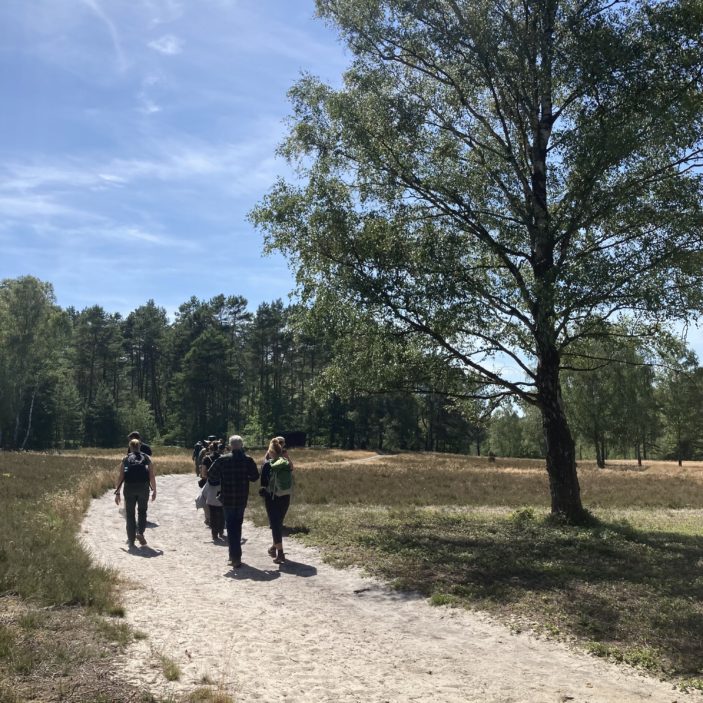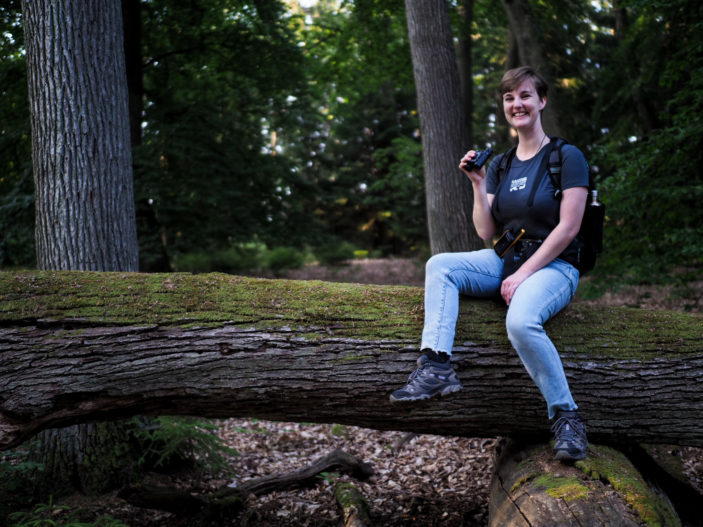
It’s 4:30 am and cold in my tent. I slowly emerge from the early morning brain fog and reach blindly to silence my phone alarm. Numbly, I pull on jeans, boots, and my new Biosphere Expeditions t-shirt, then half fall out of my tent into the brightening dawn. We congregate up at the hotel, in a dimly lit kitchen where we raid the fridge for semolina pudding topped with berry coulis and make steaming mugs of coffee. Time is disappearing quickly, so we follow the expedition leader to the car, stow our backpacks in the boot and take a moment to watch peach sunlight tinting the pale sky above golden cornfields.
Joining a wolf conservation expedition in Germany
Before I take you too far into the forests of wild Germany, let’s go back to why we’re all there. Lower Saxony hasn’t always been on my must-visit list. To be honest, it was logged under European names that sound like Grimm fairytale locations – until an opportunity arrived in my inbox to join the Biosphere Expeditions volunteer conservation expedition. I soon learnt that this global not-for-profit organisation runs ‘expeditions’ where a group of volunteers spend a week or two collecting data as ‘citizen scientists’, to aid in the conservation work of researchers. I was invited on the Germany wolf expedition, which is based near the city of Bremen and has been running since 2017.
In the last fifteen years, wolves have begun to naturally return to Germany for the first time in hundreds of years. But unfortunately, there has been a lot of push-back from the locals about whether they are safe cohabitors or whether they are endangering the livelihoods of farmers by taking livestock. Misinformation and suspicions are rife, and the antidote is research and data collection. To protect the returning wolf population and change perceptions, Biosphere has citizen scientists walking the forests of Lower Saxony and documenting any signs of wolves, such as tracks, scat, kills, and sightings. It’s work that makes a real difference, an opportunity for purpose-driven hiking and the satisfaction of a day spent doing something meaningful.
Expedition Leader, An Bollen, says: ‘The German expedition is for anyone who enjoys hiking, has a keen interest and curiosity in local wildlife, and wants to learn more about the return of the wolf in a human-controlled environment. We discover how coexistence between farmers, hunters, and people in general is possible with this predator.’
Hiking into the sunrise
The hike which had me up at the crack of dawn was the last on my trip with Biosphere Expeditions, and almost like it was meant to be, it was the most moving experience of my time in Germany. With a 39-degree day looming ahead, we had decided to start earlier than the usual 10 am and arrived at our starting point a little after five. I was paired with Kathrin, an enthusiastic German hiker and author with the perfect hiking partner qualities: skill with a camera and the ability to enjoy comfortable silence. After adjusting our equipment and setting up the GPS tracking, we set off, Kathrin with the casual stride of someone who walked these distances daily and myself in a way I hoped didn’t reveal the now familiar ache in my feet.
At a cool 18 degrees, the fresh air was invigorating and the only sounds in the forest were some particularly vocal insects. Unlike the pine plantation forests we had been walking in, this forest was biodiverse, with lush mossy ground and brilliantly green trees, interspersed with the occasional field turned brown from the heat. The pink hues of the sunrise were illuminating the trees and there was a glow at the end of the green tunnel ahead.

A wildlife encounter
Kathrin and I found a comfortable rhythm, quietly walking along opposite sides of the path and scanning the leafy ground for evidence of wolves. After so many days of heat, dwindling water supplies, and waning energy, the fresh morning felt like a rebirth. About half way through the hike, we stopped and rested on a pile of stacked logs. The treetops met above us, creating a peaceful, shady haven where we could munch on vegan muesli bars and crisps. Then, as we sat and breathed in the quiet, we heard a shuffling noise from behind the logs, in the forest.
I looked at Kathrin with hours of built-up anticipation barely contained – we had been hoping animals would emerge once we stopped making noise. “Wild boar.” she said, signalling for me to keep my composure. I leant forward to look around the edge of the logs and caught a glimpse of a small family of wild boar snuffling their way through the trees. Dark, furry shapes with their large heads plunged into the carpet of leaves at their feet. At least four white-striped piglets trotted along behind them, darting between the trees.
When you spend so long in the forest, moments like this feel like nature accepting your presence and letting you in. Rare sightings of wildlife were the reward for our days of hard work, like we had earned the trust of the forest.
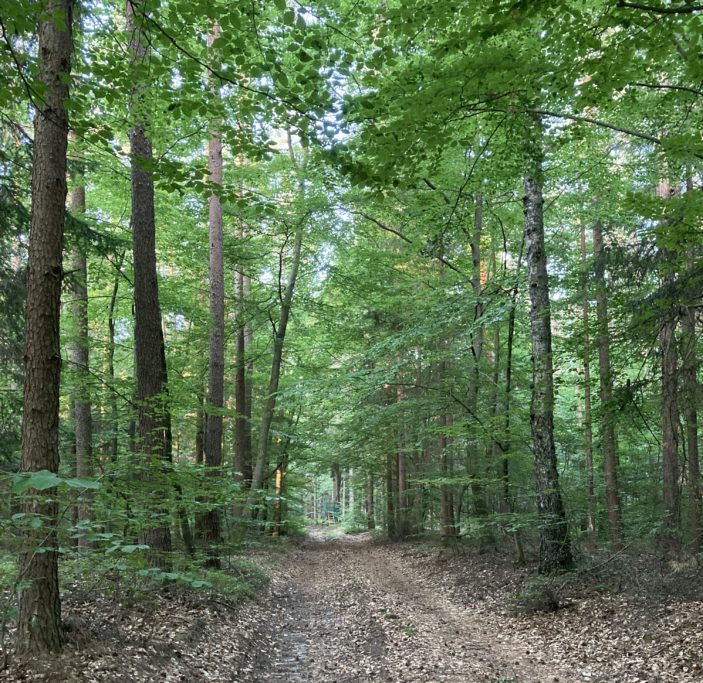
The first day: an introduction to the expedition
After a night at the quirky (and air conditioning-less) airport hotel in Bremen, I caught a taxi to the assembly point, where we had our obligatory Covid tests and bonded over the shared pursuit of wrangling baggage into the vans. Everyone was very welcoming, and it immediately felt like a low-pressure environment devoid of the seriousness that often accompanies work travel. An, the expedition leader, and Peter, the expedition scientist, were brisk but friendly people, the sort you feel safe wandering into the forest with.
Meeting the wolves
Our first stop was the Wolf Centre. We arrived after a 45-minute drive through flat farmland dotted with horses and sleepy towns of pitched red rooftops. This detour was designed to educate the group about wolves up close, imbuing us with a deeper connection to the purpose of our research. Once we had obtained some essential wolf-themed items from the gift shop and wandered through a museum – the ideal opportunity to work on our German, one plaque at a time – we headed outside for the main event.
Large, treed enclosures housed several different types of wolves, including striking white arctic wolves and the local, grey European ones. Watching them lazing in patches of sun or wandering curiously along the fence line was quite surreal, as they seemed like svelte, long-legged dogs. Our guide, who spoke about the wolves with the affectionate tone of a stern parent, explained the misconceptions about these animals and told us how we would be unlikely to see any in the wild. They were quite shy, but the warning was still pertinent: if a wild German wolf did walk towards us, all we had to do was make noise or move around. The tour concluded with us joyfully making fools of ourselves by howling and trying to get the wolves to join in; they watched bemusedly and then continued to snooze.
Our home for the week
After another hour-long drive, we were at the base. The word ‘base’ makes it sound like an army camp, but that couldn’t be further from the truth. It was a beautiful, historic hotel, the very picture of a traditional German building, tucked in amongst thriving and slightly wild forest, on the edge of a small lake. I was surprised by the luxury of my third-floor room – it was cosy and spacious, with an ensuite and glass shuttered windows that opened out into the treetops. I had a few moments to test the bed’s comfort level and unpack writing materials onto the desk before heading downstairs.
As with all the briefings we had, everyone gathered in a sunny meeting room, sat down around a semi-circle of tables, and devoured large German biscuits and delicate cups of strong filtered coffee. This time, a wolf conservation expert had come to speak with us about why the work we were doing was so important and to give context to the expedition. These talks were vital in preparing us for the moment that we would head out onto the trails.

Gathering evidence to support the return of the wolf
Everyone has an immediate, instinctive reaction to the mention of wolves. A picture of a huge snarling creature in a dark forest will appear in your mind. And that’s part of the problem. While on the expedition, I learnt something which reframed my preconceived ideas about these animals, and that was the fact that a ‘pack’ of wolves is actually just a family. In a split second, the sinister ‘pack’ becomes less scary thanks to this meaningful context. They aren’t a group of killers trying to hunt you down, just a family of animals looking after each other. Parents, pups, and siblings journeying through the forest together.
The significance of data collection
Not only are the locals in Germany nervous about the return of wolves, but the hunters and farmers are passionately campaigning against their arrival. They believe the wolves are lowering the prey populations and killing too many livestock. That’s where we come in. The volunteers on the Biosphere expeditions collect data about where the wolves are, what their movements are, and what they are eating, so that the scientists can prove how little impact they actually have.
Our job was to walk in pairs, one on each side of the path, and scan the ground for tracks, kills, or scat. It was all treated very scientifically, but the fact that we were searching for the scat left behind by wolves didn’t go unnoticed – you have to find the humour in it when you’re collecting wolf droppings in 37-degree heat! We used a GPS to track our path and then marked waypoints wherever we found evidence, we also collected any scat (hygienically, with gloves, and smell-proof containers!) so that it could be sent to a lab – the scientists would then collect DNA and discover which wolf was in the area. This way, they can track the wolves movements and also find out how many livestock and natural prey they are eating.
Exploring the forests of Lower Saxony
Every day, we would have breakfast at 7 am, pack a lunch from the buffet, and split into teams so we could cover different areas of the region. Depending on the team, it could take five minutes or up to two hours to reach your hiking location.
I’ve never felt further away from my laptop screen than when I was four hours into a hike through the German forest. When you’ve got to focus on searching for signs of wolves, it’s a bit like meditation, you can’t think about anything else except the task in front of you – there’s no choice but to stay in the moment.
Wanderers amongst the pines
My first all-day hike was in a pine plantation forest fragrant with the sharp scent of freshly cut timber. Unlike the barren plantations of Australia, the earth beneath the pine trees was thick with brown and green moss and bushes of berries, creating a strange monocultural fairytale forest. I was paired with Michael, an older man from the US who, in a broad-brimmed hat and trademark hiking gear, looked the picture of a citizen scientist.
We walked for six hours, stopping at crossroads to scan the distance with binoculars in the hopes of seeing a wolf and taking restrained sips of water as the day grew hotter. Our walk was punctuated by fields of yellow crops dotted with wind turbines and the occasional hunting tower (or ‘hunter’s high seat’) – a wooden structure, accessed by a ladder, where hunters conceal themselves and wait for game. Later, over dinner, several of the other volunteers described with some delight how they had eaten their lunch in these towers, revelling in the way the hunter’s own equipment was helping conservationists.
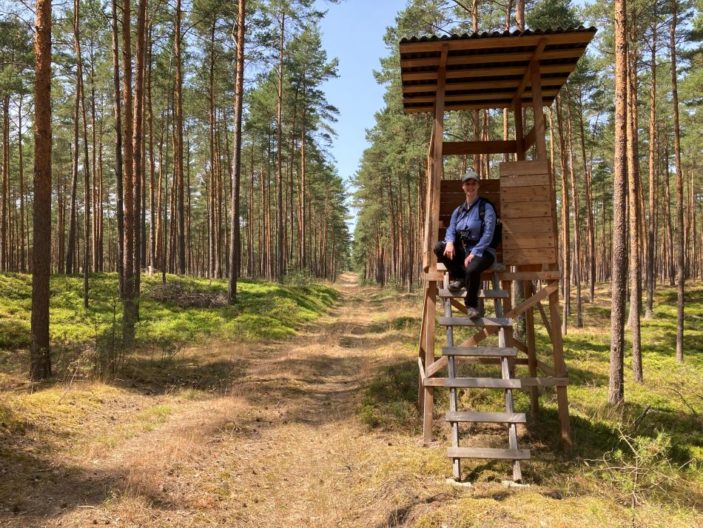
Grapes, sweat, and science
Someone who is perhaps on the opposite end of the spectrum to a hunter is Kenny from Bio-Hotel Kenners Landlust, a beautiful bohemian hotel two hours from our base. Three of the volunteers (including myself), ventured north to camp at the hotel for one night, to visit this fellow wolf enthusiast and help him monitor the movements of the wolves in the area. As always on this expedition, first impressions were not a priority, and we stopped on the way to complete a four-hour hike. It was a 37-degree day and although the trees provided much-needed shade, we ran out of water by the last half hour and arrived red-cheeked and lethargic. I’m not sure whether it was the bone-deep exhaustion or the satisfaction of making it to the end, but collapsing onto soft grass under a massive tree and eating hot grapes while watching wisps of cloud move across the sky was bliss.
After an urgent half-hour spent scouring a small German town for hydration and sugar – found in the form of icy poles, one-litre bottles of water, and lemonade – we bundled our ripe-smelling selves into the car and headed for the Bio Hotel. Luckily, Kenny was not the sort to comment on our dusty faces and sweat-slicked hair, and was solely interested in our findings. As with everyone else on this expedition, the focus was always on the science.
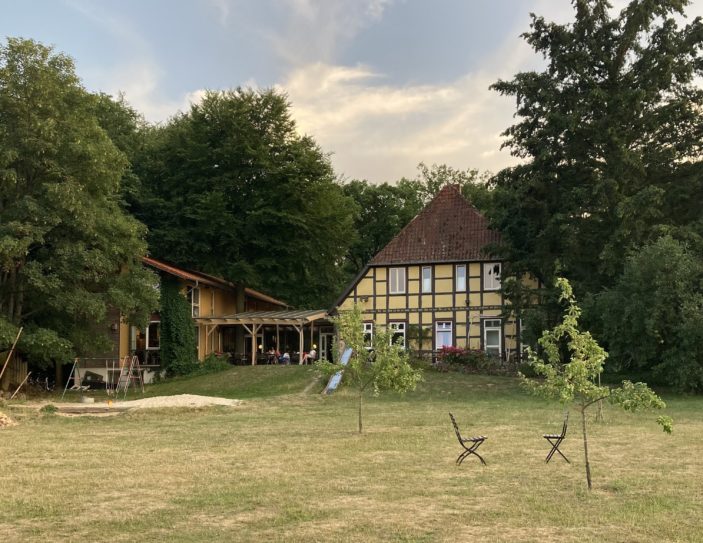
Finding connection at the base
Here’s the thing most hikers won’t admit: one of the best parts of hiking is getting home. That cool, reviving shower, fresh clothes, and a comfortable seat feels like the best thing in the world – and you can relax there, sipping wine, without guilt, because you’ve earned it! On this expedition, the high of post-exercise endorphins and jelly-like muscles were complemented by the fact you had people to enjoy it with.
The expedition brought people together who were similar in their passion for nature and conservation, but different in nearly every other way. Our group was made up of people from Germany, the UK, the US, the Netherlands, and of course Australia, with ages ranging from the mid-twenties to mid-sixties. Just like when you stay in a hostel or live in university housing, it’s remarkable how those with a variety of characters and backgrounds can find commonalities. And once you’ve spent multiple hours navigating your way through a forest with someone, there’s a bond, a camaraderie, that is formed.
The joys of food and conversation
After the essential wash and revitalisation time, we would gather in the dining room of the base (hotel) and sit down at a long table for dinner. Dinner was fully catered, with a gruff but loveable lady in a hairnet placing bowls of fresh mint soup in front of us and taking drink orders (you could ask for a wine, beer, or a ‘shandy’ and pay the total at the end of the stay). Deep buffet dishes brimming with hearty foods like potato bake and vegetable casserole would then appear on a nearby table, and we would load our plates, and return to the table for long talks and already familiar banter.
Quiet companionship in a wheat field
When we spent a night at the Bio Hotel, our evening looked a little different. The four of us: Kathrin, Ben (a British man with multiple Biosphere expeditions under his belt), An, and I were sitting at a table outside the hotel restaurant, nursing full stomachs and enjoying a soft breeze and the accompanying sound of crickets. When An suddenly suggested we take a stroll to a field where a public version of a hunting tower was located. Exchanging our usual backpacks for small bottles of rosé spritz and binoculars, our bare feet exposed in sandals for the first time in days, we walked five minutes down a deserted country road and into the fields.
The hunter’s tower was large and closer to the ground than others I had seen, with a low bench hidden behind the walls so you could sit and peek out at the surroundings. Our aim was only to witness the movements of wildlife. The key was complete silence and patience. Apart from exchanging glances and taking sips of spritz, we simply scanned the treeline with binoculars and decompressed into the calming warmth of twilight. The roe deer we watched emerge from the forest and bound through the grass were just a bonus.

Walking along the wolf’s path
Although it feels meaningful collecting data that will make a measurable difference to the conservation of German wolves, it is also impactful on a personal level when you realise how close you may have been to these intriguing animals.
The expedition leader, An Bollen, described her memorable expedition moment as: ‘Being a witness of lots of evidence of wolf presence in the Gohrde territory, a beautiful mixed forest. Photos from camera traps showed how these pups passed by there just a few days before us. It is a special feeling realising you are in wolf territory sharing the same natural environment.’
The important thing the Biosphere team wanted us to understand was that there shouldn’t be a question as to whether the wolves should return, they already have, and it’s not up to us.
For more details about the Biosphere Expeditions volunteer wolf expedition in Germany, which runs from the 1-7 July 2023 and the 8-14 July 2023, head HERE.
The author attended the expedition as a guest of Biosphere Expeditions. Photos by the author except for the ones with the author featured, these were taken by fellow expeditioner Kathrin Heckmann.

